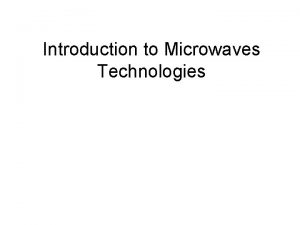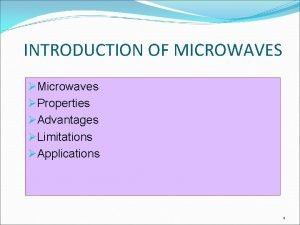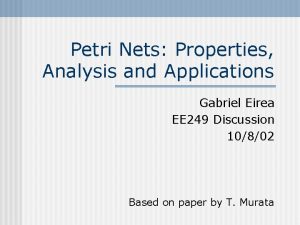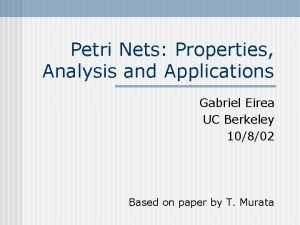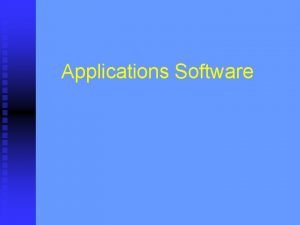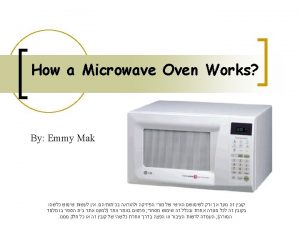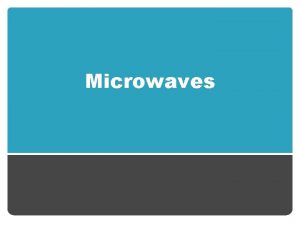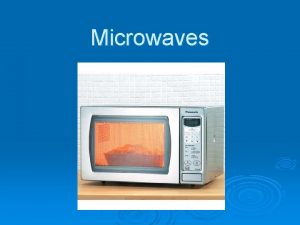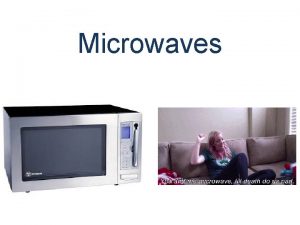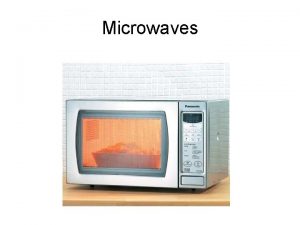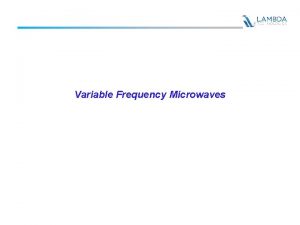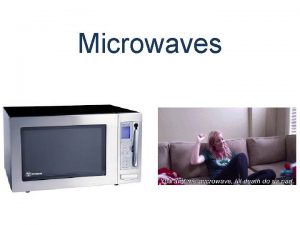INTRODUCTION OF MICROWAVES Microwaves Properties Advantages Limitations Applications










- Slides: 10

INTRODUCTION OF MICROWAVES ØMicrowaves ØProperties ØAdvantages ØLimitations ØApplications 1

Electro Magnetic Spectrum 2

Microwaves ØMicrowaves are electromagnetic waves whose frequencies range from about 300 MHz – 300 GHz (1 MHz = 10 6 Hz and 1 GHz = 10 9 Hz) or wavelengths in air ranging from 100 cm – 1 mm. ØThe word Microwave means very short wave, which is the shortest wavelength region of the radio spectrum and a part of the electromagnetic spectrum. 3

Properties of Microwaves 1. Microwave is an electromagnetic radiation of short wavelength. 2. They can reflect by conducting surfaces just like optical waves since they travel in straight line. 3. Microwave currents flow through a thin outer layer of an ordinary cable. 4. Microwaves are easily attenuated within short distances. 5. They are not reflected by ionosphere 4

Advantages and Limitations 1. Increased bandwidth availability: Ø Microwaves have large bandwidths compared to the common bands like short waves (SW), ultrahigh frequency (UHF) waves, etc. Ø For example, the microwaves extending from = 1 cm - = 10 cm (i. e) from 30, 000 MHz – 3000 MHz, this region has a bandwidth of 27, 000 MHz. 2. Improved directive properties: Ø The second advantage of microwaves is their ability to use high gain directive antennas, any EM wave can be focused in a specified direction (Just as the focusing of light rays with lenses or reflectors) 5

Advantages and Limitations 3. Fading effect and reliability: Ø Fading effect due to the variation in the transmission medium is more effective at low frequency. Ø Due to the Line of Sight (LOS) propagation and high frequencies, there is less fading effect and hence microwave communication is more reliable. 4. Power requirements: Ø Transmitter / receiver power requirements are pretty low at microwave frequencies compared to that at short wave band. 6

Advantages and Limitations 5. Transparency property of microwaves: Ø Microwave frequency band ranging from 300 MHz – 10 GHz are capable of freely propagating through the atmosphere. Ø The presence of such a transparent window in a microwave band facilitates the study of microwave radiation from the sun and stars in radio astronomical research of space. 7

Applications Ø Microwaves have a wide range of applications in modern technology, which are listed below 1. Telecommunication: Intercontinental Telephone and TV, space communication (Earth – to – space and space – to – Earth), telemetry communication link for railways etc. Radars: detect aircraft, track / guide supersonic missiles, observe and track weather patterns, air traffic control (ATC), burglar alarms, garage door openers, police speed detectors etc. 2. 8

3. Commercial and industrial applications Ø Ø Ø Ø Microwave oven Drying machines – textile, food and paper industry for drying clothes, potato chips, printed matters etc. Food process industry – Precooling / cooking, pasteurization / sterility, hat frozen / refrigerated precooled meats, roasting of food grains / beans. Rubber industry / plastics / chemical / forest product industries Mining / public works, breaking rocks, tunnel boring, drying / breaking up concrete, breaking up coal seams, curing of cement. Drying inks / drying textiles, drying / sterilizing grains, drying / sterilizing pharmaceuticals, leather, tobacco, power transmission. Biomedical Applications ( diagnostic / therapeutic ) – diathermy for localized superficial heating, deep electromagnetic heating for treatment of cancer, hyperthermia ( local, regional or whole body for cancer therapy). 9

Other Applications 4. Identifying objects or personnel by non – contact method. 5. Light generated charge carriers in a microwave semiconductor make it possible to create a whole new world of microwave devices, fast jitter free switches, phase shifters, HF generators, etc. 10
 Properties of microwaves
Properties of microwaves Introduction to microwaves
Introduction to microwaves Differences between people as media and people in media
Differences between people as media and people in media Non colligative properties
Non colligative properties Applications of colligative properties in foods
Applications of colligative properties in foods Petri nets properties analysis and applications
Petri nets properties analysis and applications Gabriel y petri
Gabriel y petri Advantages of integrated software applications
Advantages of integrated software applications What are microwaves
What are microwaves The electromagnetic spectrum song lyrics
The electromagnetic spectrum song lyrics What molecules are microwaves most attracted to
What molecules are microwaves most attracted to
